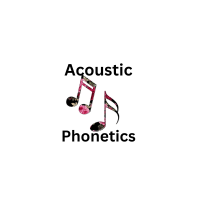Acoustic Phonetics

About Acoustic Phonetics
Let’s dive into the world of Acoustic Phonetics, where we’ll explore how speech sounds are transformed into sound waves and examine the properties of those waves. Here’s an introduction to get you started:
Acoustic Phonetics:
Unveiling the Sound Waves of Speech: Have you ever wondered how the sounds we produce with our vocal organs become the words we hear?
Acoustic phonetics is like the magical translator that turns the intricate dance of our articulatory movements into the mesmerizing symphony of sound waves.
It’s the study of how speech sounds are transformed into waves that travel through the air to reach our ears.
Sound Waves:
The Building Blocks of Speech: Imagine sound as a series of ripples in a pond, spreading out from a stone’s impact. In speech, those ripples become waves of compressed and rarefied air, creating a rich tapestry of sound.
Frequency and Pitch:
One of the key concepts in acoustic phonetics is frequency. This refers to how many cycles a sound wave completes in a second.
Higher frequency waves create higher-pitched sounds, while lower frequencies result in lower-pitched sounds.
Think of it like the notes on a musical scale – each sound has its own pitch.
Amplitude and Volume:
The height of a sound wave is its amplitude. This determines the volume or loudness of a sound.
Larger amplitudes create louder sounds, while smaller amplitudes create softer ones.
So, whether you’re whispering or shouting, you’re adjusting the amplitude of your sound waves.
Duration and Timing:
The duration of a sound is how long it lasts.
Short sounds like p have brief durations, while longer sounds like s are more extended.
The timing and sequence of these sounds create the rhythm and tempo of spoken language.
Analyzing Speech Sounds:
Acoustic phonetics lets us examine the subtle differences between speech sounds.
By measuring the frequency, amplitude, and duration of sound waves, we can pinpoint the unique characteristics of each sound.
This analysis helps linguists understand why certain sounds sound different and how they’re produced.
Technology and Applications:
Acoustic phonetics is not just about understanding speech – it has real-world applications too. It’s the foundation for technologies like speech recognition, helping computers understand and respond to human speech.
It’s also crucial in fields like linguistics, communication disorders, and language teaching.
Your Sonic Journey Begins:
With acoustic phonetics, you’re venturing into a world where invisible waves become the music of language.
You’ll discover how the sounds we create transform into vibrations in the air, journeying from one person’s vocal cords to another person’s ears.
As you explore further, you’ll gain a profound appreciation for the intricate science behind spoken communication
.click here Acoustic Phonetics
click here Articulatory Phonetics
click here English Phonetics
click here About Phonetics
click here Grammar